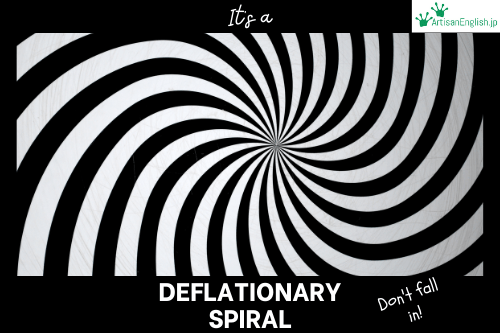
YouTube / iTunes / Spotify / Radio Public / Pocket Casts / Google Podcasts / Breaker / Overcast
Listen to ArtisanEnglish.jp posts & lesson intros here.
WotD: Deflationary spiral
Now and then, someone will ask me what it’s like to live in Japan.
I used to say it’s like eating fried chicken through a straw.
Now I say it’s like feeling dizzy all the time.
Why dizzy?
A deflationary spiral occurs after an economic crisis but leads to lower production, lower wages, decreased demand and lower prices.
I’ve been riding a deflationary spiral in Japan.
Honestly, I’ve never paid a high price for anything since coming here.
Prices are already low, and prices can always be negotiated lower because I live in Kansai.
Also, in Japan, if you want to buy something, wait a little while, and the government will have a special subsidy program for it.
So far, it’s been heaven living in a deflationary spiral.
When I purchased my car, I received a government discount and negotiated down from there.
We just purchased two toilets with a 50% subsidy from our town as long as we used local contractors.
Heck, just last week, fibre optic Internet was installed in our home for free, compliments of a government subsidy.
Why live anywhere else?
Unfortunately, a deflationary spiral is not all rainbows and unicorns.
There is a dark side, a very dark side.
A deflationary spiral occurs after an economic crisis but leads to lower production, lower wages, decreased demand, lower prices, and in Japan’s case, the lowest productivity in the G7.
Recent university graduates begin with salaries lower than in developing countries, and they don’t go up much from there compared to North America or Europe.
That’s why prices are so low.
Some may argue Tokyo is expensive, but that’s Tokyo.
Step across the city boundary, and prices for everything drop drastically.
A deflationary spiral has its benefits, but it may become a death spiral if it goes on for too long.
Flesch-Kincaid Readability Test
This post is understandable by someone with at least an 8th-grade education (age 13 – 14).
On the Flesch-Kincaid reading-ease test, this post scores 66.
The easier a passage is to read, the higher the score on a scale of 0 – 100.